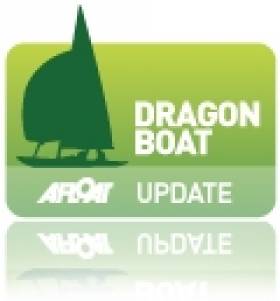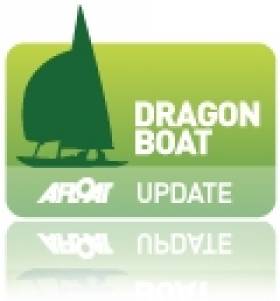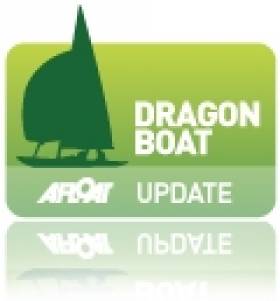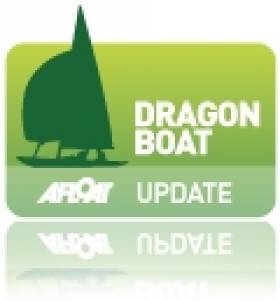Displaying items by tag: Dragon
UAE Bunker Boys Are New Dragon World Champions
#dragon – The final day of the Dragon worlds in La Rochelle began with a short delay to allow the wind to settle after an overnight front had seen rain move up from Bordeaux. This more or less prevented any chance of two races, so when the fleet eventually left the marina we all knew it would be just one final race.
With an overnight lead of 10pts UAE 8 only had to keep a couple of boats in their sights to guarantee victory... indeed that is exactly what they did.
The race started with a westerly breeze of around 10kts, boats that chose the right side of the course made out better than the left. However, go too far right and it was possible to over-stand the first mark and that is exactly what a large group of competitors did. The three boats that sailed the first beat perfectly were UAE 7 Markus Wieser, RUS 27 Anatoly Loginov and GER 1123 Michael Zankel. Although there were a few place changes throughout the race, this was the finishing order of the top three boats
Meanwhile UAE 8 made their way up through the fleet to finish 10th, RUS 76 had a fine race to make it to 8th place and take the Silver Medal spot, but GER 11 dropped back to 22nd and thus out of the top three overall. However, Markus Wieser's excellent final race win, rewarded his team with the final podium position and the Bronze Medal at this fantastic Championship.
Final top five
1. Bunker Boys, Yevgen Braslavets / Aleksander Mirchuk / Sergiy Timokhov, UAE, 26 points
2. Stange Little Girl, Dimitri Samokhi. / Andrey Kirilyuk / Aleksey Bushuev, RUS, 45
3. Bunker Queen, Markus Wieser / Sergey Pugachev / Georgil Leonchuk, UAE, 47
4. BBXXL Vincent Hoesch / Markus Steinlein / Marc Pickel , GER, 48
5. Desert Eagle, Hendrik Witzmann / Henrique Anjos / Markus Ko, 75
#dragon – Andrew Craig's Chimaera topped a 13–boat Dragon fleet to win the East Coast Championships at the Royal St. George Yacht Club at the weekend. Second on the Dublin Bay race track was Craig's club mate Phantom skippered by Neil Hegarty with Kinsale Yacht Club's Little Fella Cameron Good third overall.
Counting five top three results, including two races wins, Craig of the host club, emerged two points clear of Hegarty after discarding an eighth in the final sixth race. Full results downloadable below.
#dbsc – BENETEAU 31.7 Echo- 1. Prospect (Chris Johnston), 2. Levante (M.Leahy/J.Power), 3. Extreme Reality (P.McSwiney/E.O'Rafferty)
BENETEAU 31.7 - 1. Prospect (Chris Johnston), 2. Levana (Jean Mitton), 3. Crazy Horse (F Heath & I Schuster)
CRUISERS 0 Echo - 1. Tsunami (Vincent Farrell), 2. Aurelia (Chris Power Smith), 3. Wow (George Sisk)
CRUISERS 0 - 1. Tsunami (Vincent Farrell), 2. Wow (George Sisk), 3. Aurelia (Chris Power Smith)
CRUISERS 1 - 1. Ruth (L Shanahan), 2. Jalapeno (P Barrington et al), 3. Something Else (J.Hall et al)
CRUISERS 1 Echo - 1. Ruth (L Shanahan), 2. Jalapeno (P Barrington et al), 3. Something Else (J.Hall et al)
CRUISERS 2 Echo - 1. Jester (Declan Curtin), 2. Antix (D Ryan), 3. Peridot (Jim McCann et al)
CRUISERS 2 - 1. Jester (Declan Curtin), 2. Peridot (Jim McCann et al), 3. Jambiya (Ryan & Lattimore)
CRUISERS 3 A Echo - 1. Hard on Port (F O'Driscoll), 2. Quest (B Cunningham), 3. Cries of Passion (B Maguire)
CRUISERS 3 A - 1. Quest (B Cunningham), 2. Hard on Port (F O'Driscoll), 3. Cries of Passion (B Maguire)
CRUISERS 3 B - 1. Asterix (Counihan/Meredith/Bushell), 2. Cacciatore (M Ni Cheallachain), 3. Taiscealai (B Richardson)
CRUISERS 3 B Echo - 1. Jiminy Cricket (M Tyndall), 2. Small Wonder (H Kelly), 3. Saki (Paget McCormack et al)
Combined Classes Echo - 1. White Mischief (Timothy Goodbody), 2. Rupert (R & P Lovegrove), 3. Jester (Declan Curtin)
Combined Classes - 1. White Mischief (Timothy Goodbody), 2. Rupert (R & P Lovegrove), 3. Jester (Declan Curtin)
DRAGON - 1. Diva (R.Johnson/R.Goodbody), 2. Phantom (D.Williams), 3. Zinzan (Daniel O'Connor et al)
FLYING FIFTEEN - 1. Ignis Caput (David Mulvey), 2. Betty (D & S Gorman), 3. Fflogger (Alan Dooley)
GLEN - 1. Glenmiller (P Cusack), 2. Glenmarissa (F.Elmes), 3. Glendun (B.Denham et al)
RUFFIAN 23 - 1. Shannagh (S.Gill/P.MacDiarmada), 2. Diane ll (A Claffey/C Helme), 3. Bandit (Kirwan/Cullen/Brown)
SB20 - 1. Venuesworld.com (Ger Dempsey), 2. Sin Bin (Michael O'Connor)
SHIPMAN - 1. Jo Slim (J.Clarke et al), 2. Euphanzel lll (M Muldoon), 3. Gusto (Heath, Miles, Crisp, Duggan)
SIGMA 33 - 1. White Mischief (Timothy Goodbody), 2. Rupert (R & P Lovegrove), 3. Leeuwin (H&C Leonard & B Kerr)
SIGMA 33 - 1. White Mischief (Timothy Goodbody), 2. Rupert (R & P Lovegrove), 3. Popje (Ted McCourt)
SQUIB - 1. Perfection (Jill Fleming), 2. Sidewinder (R&R Westrup), 3. Femme Fatale (V Delaney)
WHITE SAIL CRUISERS Echo - 1. More Mischief (Eamonn Doyle), 2. White Lotus (Paul Tully), 3. Just Jasmin (Philip Smith)
WHITE SAIL CRUISERS - 1. Persistence (C. Broadhead et al), 2. White Lotus (Paul Tully), 3. Act Two (Michael O'Leary et al)
Dublin Bay Dragon Fleet Welcomes Back Olympic Campaigners Max Treacy & Anthony Shanks
#dragon – Saturday saw two competitive races for Dragons out of Scotsman's Bay on the southside of Dublin Bay. Winds were Light to moderate in a Northerly direction. The fleet welcomed back Max Treacy and Anthony Shanks, with Paul Maguire, aboard 198. As well as guest crew with Phantom (176), ZinZan (127) and Sir Ossis (1). Great credit goes to Vice-Captain Ronan Murphy Race Officer for the day, who set two excellent courses (about 50 mins. duration) from a RIB assisted by a mark-laying RIB from the Royal St George YC. A good day out - a tad chilly - this format will be repeated again over the season!
#dragon – The weekend's Cannonball Trophy saield on Dublin Bay is an annual team racing event sailed by Dragon sailors from The Royal London Yacht Club in Cowes, The Royal Netherlands Yacht Club in Muidan Holland and The Royal St George Yacht Club in Dun Laoghaire. Occasionally the Dragon sailors from Deauville Yacht Club in France also compete but they were unavailable to travel this year.
Racing is held on a Friday & Saturday in April.
This year they sailed in glorious conditions on Friday in Scotsmans Bay with about 10knots of breeze. We used an equalised fleet of 1720's from three of the waterfront Clubs in Dun Laoghaire for the event. Two Rounds were sailed on Friday where the London Dragons ended up with just one extra race win ahead of the Dublin Bay Dragon Fleet. The fleet were expected to go into a five race final against each other on Saturday but this was not to happen as the Race Officer deemed the 20–knot conditions to be unsafe for racing.
The event is as much about the socials as it is about racing. The sailors were treated to a night of traditional Irish entertainment in Johnny Fox's Pub in the Dublin mountains on Friday evening. On Saturday after racing was cancelled they headed on the DART to Howth for a long lunch in Aqua Restaurant before returning to the Royal St George for a dinner & prize giving.
The Dublin Bay Dragon helms were: Martin Byrne, Andrew Craig & Tim Pearson.
Dragon 'U-Boat' at Cascais
#dragon – The popular European International Dragon Winter Series at Cascais in Portugal got off to a spectacular start over the weekend.
After a week of strong winds, the breeze had eased, but a huge leftover sea still running in the Atlantic was a timely reminder that further along the Portuguese West Coast, they have a breaker which rivals Ireland's mighty Aileens off the Cliffs of Moher.
For those who could handle the conditions, the sailing was spectacular.
However, the word is that it was an un-released runner which caused a mark-rounding German Dragon to be knocked on its side and fill.
Whatever the reasons, quips about U-Boats in the Battle of the Atlantic were thought to be in the worst possible taste.
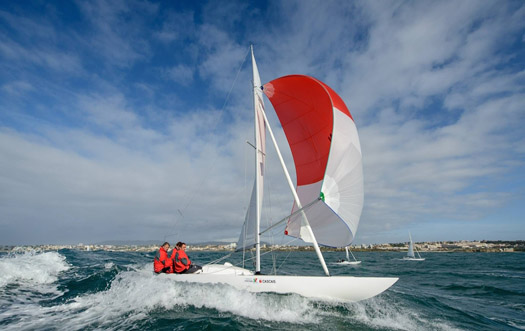
Big seas, big sunshine – the weekend's Dragon Racing at Cascais as it might have been...
Lough Derg Drubbing For Some, But Dragons & Squibs Rise Above It
#loughderg – Lough Derg's annual Keelboat Freshwater Regatta in October is meant to round out the season with some gentle lake sailing for salty folk in big boats. But 2014's event last weekend was just too near a ferociously active bad weather system which had lows sometimes down to the 950s spinning around each other out in the Atlantic close to Ireland's West Coast. Thus although it was possible to get in the racing in the CH Marine Autumn Series down at Crosshaven, while the MSL Park Motors Autumn League at Howth concluded in balmy if breezy conditions across on the east coast, over to the west on Lough Derg they were lashed by the tails of two storms, and two classes failed to get any racing at all. But if you happened to be with the stately Dragons or the perky Squibs, then there was some great sport which has W M Nixon reflecting on the way our keelboat classes are developing.
Of all Ireland's lakes, it is Lough Derg which most truly merits the description of "Inland Sea'. Lough Neagh may have greater area, but in the final analysis it's only an oddly characterless shallow basin which happens to be filled with water. Lough Erne is marvellous, but too convoluted. Lough Ree has the area and the intricate coastline, but lacks the scenery. And while Lough Corrib is right up there in the beauty stakes, it's isolated from the rest of the world.
But Lough Derg – now there really is a proper inland sea. It has splendid scenery, and historic little ports with ancient quaysides all round its complex coastline, while beside them you'll find modern marinas which host an astonishing variety and number of boats, including some quite substantial sailing cruisers.
Not only is it a splendid place unto itself, but Lough Derg is part of the greater world. From it, you can undertake inland voyages to every part of Ireland, yet it takes only a day to access the sea and the oceans beyond. It's the sort of place where boating and sailing ambitions can seem endless, so it's not surprising that in recent years the Autumn keelboat regatta has become a trendy annual fixture.
Last weekend, sixty boats from four classes headed Dromineer way, to a hospitable bay and village where Lough Derg YC has been established since 1835. Keelboat racing is nothing new on Lough Derg, but boat numbers at this level is something new, and the logistics of getting the visitors launched, and organising racing on two courses when the weather was being massively unco-operative, caused something of an overload on the club system.
As well, being slightly later in October than is usual, some key members of LDYC's small core of voluntary workers afloat and ashore were already out of the country on their usual mid-Autumn breaks. So although it would have been manageable if the weather had been clement, with the main part of the racing planned for mid-lake there simply weren't the service boats and personnel available to make a sudden shift of some of the racing to a second inshore course in Dromineer Bay.
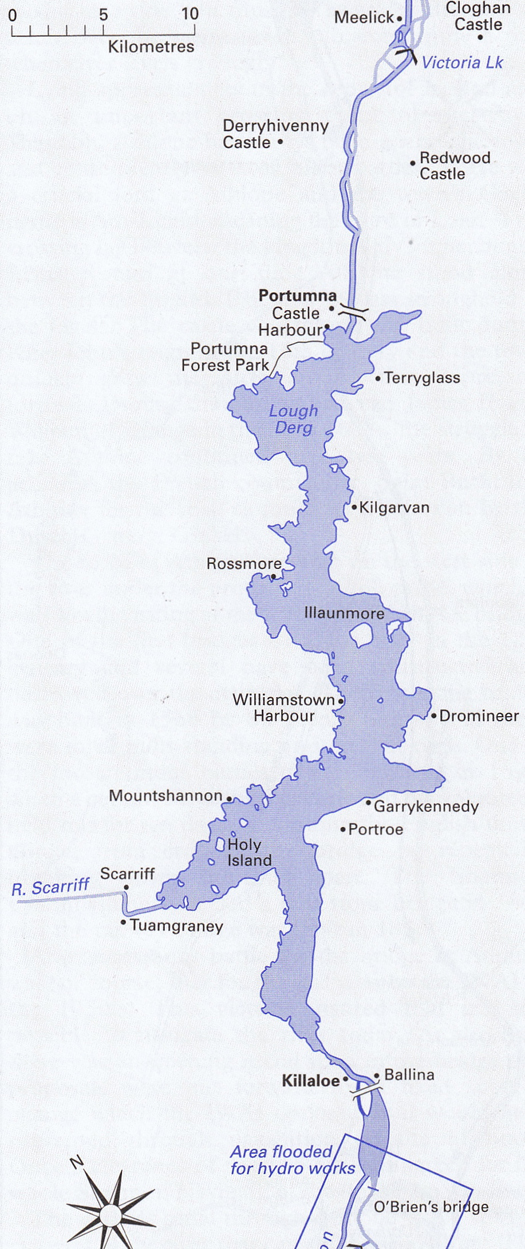
Lough Derg isn't just a lake – it's a proper inland sea with connections to the wide world.
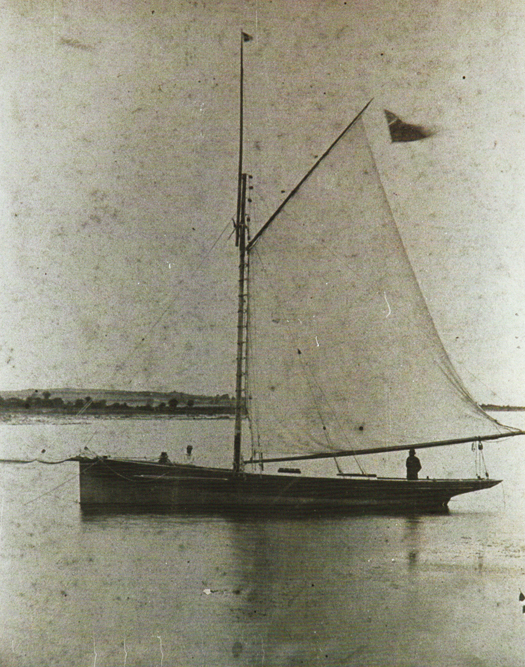
There's nothing new about keelboats on Lough Derg. This is the 7-ton cutter Tessa (Trahern Holmes, LDYC) on the lake in 1884......
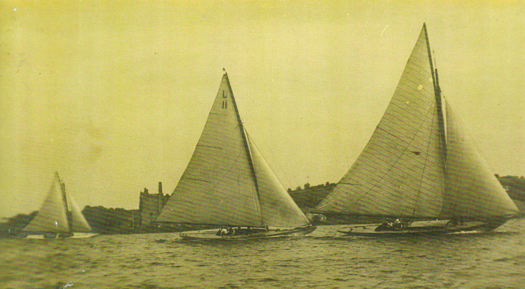
....and this is the keelboat class at Dromineer in the late 1920s. The Bermuda rigged sail number L11 is a former Olympic 6 Metre from Finland
Happily for the Dragons racing in their well-established challenge for the Jack Craig Cup, the trophy which started the whole Dromineer Autumn Keelboat event, their racing was planned for three days. In the end, they only managed the required mid-lake racing on the Friday, but it gave great sport.
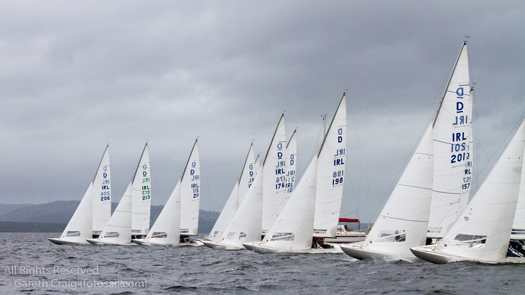 The Dragons start on the Friday. It was the introduction of the Jack Craig Cup for the International Dragons which inaugurated the Lough Derg Keelboat Regatta. The overall winner was to be Phantom (Neil Hegarty, RStGYC, no 176) Photo: Gareth Craig/fotosail
The Dragons start on the Friday. It was the introduction of the Jack Craig Cup for the International Dragons which inaugurated the Lough Derg Keelboat Regatta. The overall winner was to be Phantom (Neil Hegarty, RStGYC, no 176) Photo: Gareth Craig/fotosail
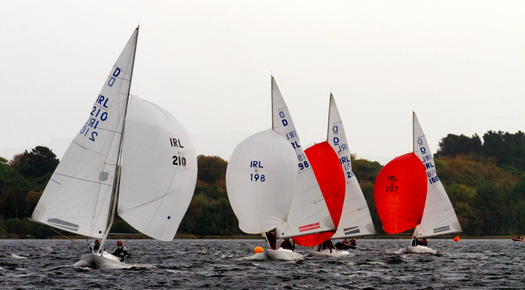
Diva (Richard Goodbody) holds the lead downwind from Dublin Bay (Gary Treacy), Little Fella (Cameron Good) and Mar J (Adrian Bendon) Photo Gareth Craig/fotosail
 When the going was good for the Dragons at Dromineer, it was very good. Gary Treacy's Dublin Bay from Dun Laoghaire and Adrian Bendon's Mar J from Kinsale neck and neck on the run, with Lough Derg YC's clubhouse and harbour on the shoreline beyond. Photo: Gareth Craig/fotosail
When the going was good for the Dragons at Dromineer, it was very good. Gary Treacy's Dublin Bay from Dun Laoghaire and Adrian Bendon's Mar J from Kinsale neck and neck on the run, with Lough Derg YC's clubhouse and harbour on the shoreline beyond. Photo: Gareth Craig/fotosail

Gary Treacy's Dublin Bay settles into the groove upwind. Photo: Gareth Craig /fotosail

Richard Goodbody's Diva showing the form which won second overall. Photo: Gareth Craig/fotosail
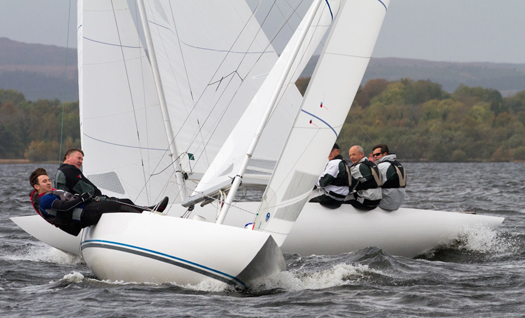
Martin Byrne's Jaguar at the finish on starboard. A former Edinburgh Cup winner, Jaguar placed third on Lough Derg. Photo: Gareth Craig/fotosail
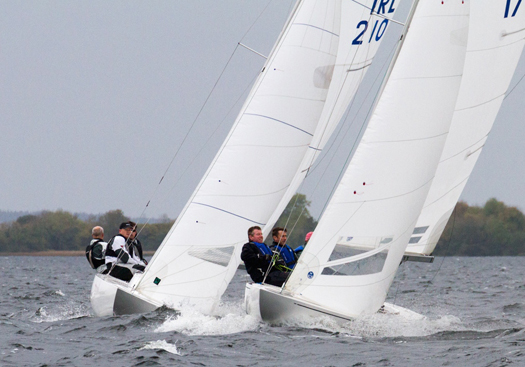
The Lough Derg 2014 Dragon Champions – Neil Hegarty's Phantom (right) won from Richard Goodbody's Diva (left). Photo: Gareth Craig/fotosail
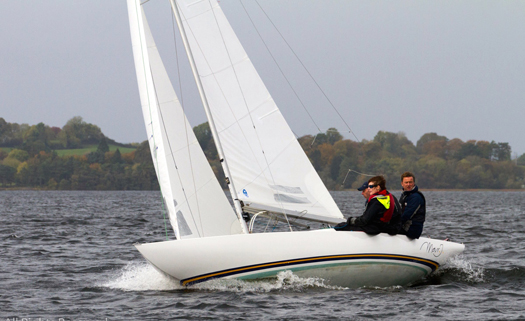 Autumn sailing at its best – Adrian Bendon's Mar J from Kinsale closes in on the finish and tenth place overall at Dromineer. Photo: Gareth Craig/fotosail
Autumn sailing at its best – Adrian Bendon's Mar J from Kinsale closes in on the finish and tenth place overall at Dromineer. Photo: Gareth Craig/fotosail
However, for the SB20s and the Flying Fifteens, trying to race the same waters on Saturday proved a non-event, and again on Sunday too. All of which made it even more galling that the Squibs, the biggest fleet of all, had requested their own simple windward-leeward course set further into Dromineer Bay on the Saturday. As long as the wind stayed in the south, the Squibs were able to race on into Saturday afternoon until, with a slight veering and further freshening of the already strong wind, all options were off.
Then on the Sunday with the wind firmly in the southwest and strong, only the Squibs had racing with one contest out on the lake, and another – with very short legs – in the inner bay. With hindsight, it seems reasonable to think that room might have been found in the bay for the two other classes of smaller boats, though admittedly the SB20s at full cry do need quite a bit of space. But that would have needed some very slick manoeuvres by more supporting RIBs, committee boats and personnel than were available.
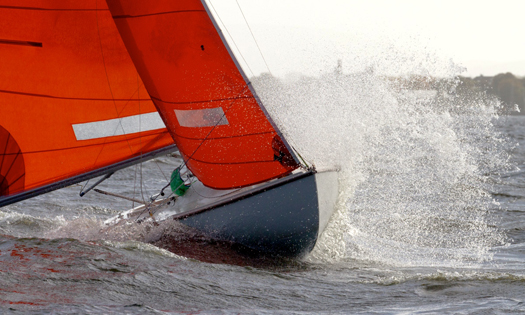
Revelling in it. Veteran skipper Vincent Delany (who also races Water Wags and Shannon ODs) puts his vintage Squib Femme Fatale (no 24) through her paces on Lough Derg. Photo: Gareth Craig/fotosail
Come to think of it, the Dragons might also have been given racing on Saturday morning if they'd been prepared to set out early and get over to the shelter of the Garrykennedy shore. But in truth, after their super sailing during Friday, the night had passed in turbo-powered conviviality, and as the Dragon crews came very slowly to life on Saturday morning on various motor-cruisers and in other accommodation, they reckoned to let the approaching storm have its way, and made arrangements to watch the rugby in the Whiskey Still in Dromineer, while other more intrepid Dragoneers battled across the lake in their vast hired Shannon motor-cruiser for a slight change of scene to watch the match in Larkin's of Garrykennedy.
But meanwhile the little Squibs were having themselves a fine old time. It was of extra interest in Dromineer, as that great stalwart of Shannon sailing Reggie Goodbody, supported by David Meredith and others, has been quietly beavering away during the past couple of years to get the Squibs going as a local class at Lough Derg Yacht Club.
As of Thursday of this week, they'd got numbers up to nine boats with others interested, which is good going from a standing start late in the summer of 2012. And though they knew that Squibs from the more experienced classes from all round Ireland would be giving them a hard time on the water, they were there ready and willing to welcome them as they drove into Dromineer on the Friday night last weekend, with twenty visiting Squibs being rigged and launched in one-and-a-half hours.
The Lough Derg people are keen to keep their new class in manageable parameters, so they've set a purchase price limit of €4,500 on people buying Squibs new to the area, which still allows for shrewd purchases in sailing centres in Great Britain, where at this time of the year it's a happy hunting ground for Squib seekers.
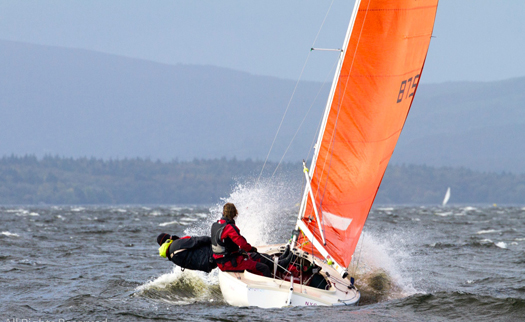
The breeze is building. One of the newest Squibs racing was Tonia McAllister's Pintail from the National YC, which finished 7th. Photo: Gareth Craig/fotosail
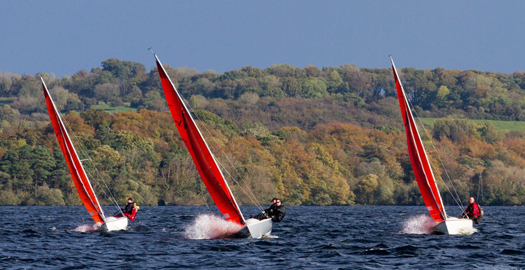 Storm? What storm? Despite dire weather predictions, at first on the Saturday morning the Squibs had perfect sailing conditions. Photo: Gareth Craig/fotosail
Storm? What storm? Despite dire weather predictions, at first on the Saturday morning the Squibs had perfect sailing conditions. Photo: Gareth Craig/fotosail
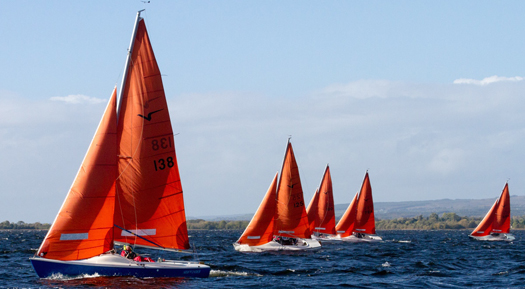 Sailing as it should be. In foreground is Rupert Bowen's Sidewinder (138, RStGYC) and beyond is clubmate Gerry O'Connor's Buzzlite (125). Photo: Gareth Craig/fotosail
Sailing as it should be. In foreground is Rupert Bowen's Sidewinder (138, RStGYC) and beyond is clubmate Gerry O'Connor's Buzzlite (125). Photo: Gareth Craig/fotosail
The attraction of the Squib for Dromineer is that it is so easily managed and maintained, a real bonus for people who may find they no longer have the energy and enthusiasm to maintain and tune a Shannon One Design, let alone the athletic ability to race one flat out. As I well recall from my own happy year of owning a Squib, they really are proper little sit-in keelboats despite being only 19ft LOA, and with our family including three small boys, a Squib proved ideal for mini-cruises along the Fingal coast and out to the islands of Ireland's Eye and Lambay, while the rapid development of the class at Howth meant we were getting good racing by the early summer of 1979.

One of the attractions of the Squib is that though she is only 19ft long, there's a proper sit-in cockpit. These are some very junior Nixons sailing on the family Squib Huppatee while returning to Howth from Ireland's Eye (hence the dinghy towing astern) in 1979. The only drawback of the Squib was she had only one tiller, so not all could steer, thus the most junior crewmember needed special consolation from his Mum.
These days the Squibs in Howth are in something of a fallow period, as many of the people who would have raced the boat in times past have moved on and up to the Puppeteer 22 which, with its little cabin and easily handled fractional rig, ticks very many boxes. However, the British & Irish Squib Championship 2015 is scheduled for Howth next June 26th- July 3rd, so doubtless that will lead to a local revival, though whether the magic number of a hundred boat racing in the same championship at the Howth venue in 1996 will be reached again is a moot point.
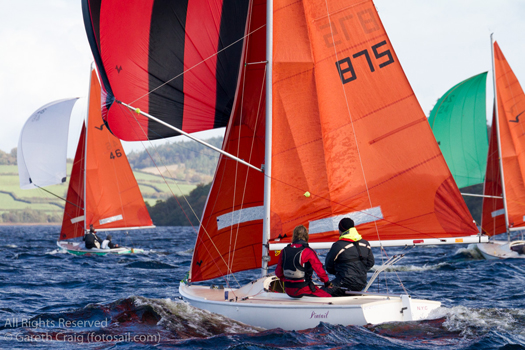
Off Dromineer, there's starting to be a real bite to the breeze as Pintail chases Femme Fatale (right) and Lola..........Photo: Gareth Craig/fotosail
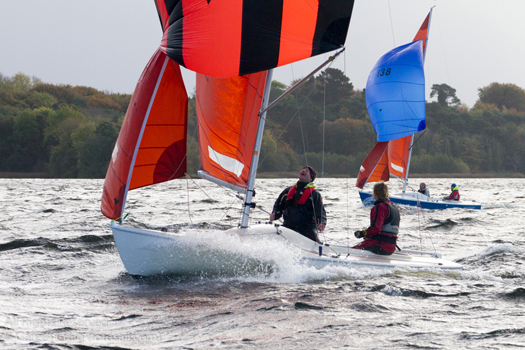
....while keeping an eye on Sidewinder off the starboard quarter. Photo: Gareth Craig/fotosail
But you never know. New boats are being built, so the class's enduring attraction is still proven, and certainly the way they got themselves back into some very confined berths at Dromineer on Saturday afternoon as further racing was being blown out was testament to their quality design and very positive handling qualities. Admittedly they may seem almost too smoothly-handling for sailing's thrill seekers, but growing classes in Dun Laoghaire and Kinsale, and the continuing health of the Squib fleets in Northern Ireland, means that the new Squib fleet at Lough Derg need never feel lonely.
That said, because the Squib has a countrywide spread, trying to keep it first and foremost a local class - as they hope to do at Dromineer - is quite a challenge. Many inshore keelboat classes today find they are becoming event boats, with crew concentrating on big happenings to which they travel perhaps every other weekend, or every three weeks or so, and they simply don't bother trying to keep up the twice-weekly commitment of club racing.

Experiment under way. Jill Fleming of Dun Laoghaire was testing a new variant on Squib sails, but although her rig looked very potent, she was back in 8th place overall with seven suits of standard tan sails ahead of her. Photo: Gareth Craig/fotosail
Certainly that's often the case with the Dragons, but then the Dragon class in Ireland offers its members a very attractive package of events all round the country at the most pleasant and glamorous sailing centres. Thus Dragon racing today in Ireland is a high-powered and potentially very expensive way of sailing, and just about as far removed as possible from Reggie Goodbody's ambitions for inexpensive Squibs at Dromineer.
He hopes to see the them develop as a good-value local class which will bring life back to Lough Derg Yacht Club during the more everyday times, when there isn't a championship going on, or it isn't the annual Lough Derg Week in August. This isn't at all the style of the Dragons' jet-setters – they're big-event performers.
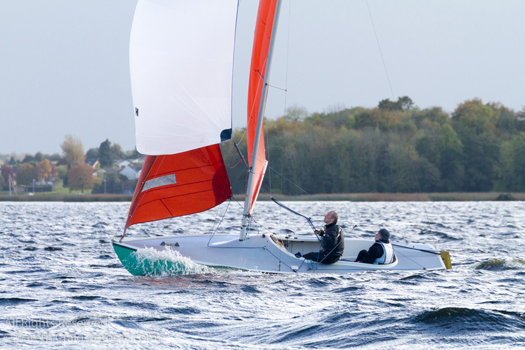
Cool sailing. One of the reasons the Squib appeals to former Shannon One Design sailors in Dromineer is that even on a busy run, you can still be relaxed and comfortable (very comfortable for the helmsman), whereas a SOD would be providing a hairy ride. Photo: Gareth Craig/fotosail
So it was fascinating to see the two very different classes sharing the lake and harbour space at Dromineer, though it was clear that if you wished to take the cheque book sailing route, the Squibs offer that as well, so Reggie and his team will have to keep the expenditure lid very firmly clamped in place.
The racing results well reflected the nationwide appeal of this event, for though the Dragons may seem to have emerged with a Dun Laoghaire dominance, winner Neil Hegarty of Royal St George YC originally hailed from Cork, and Cameron Good of Kinsale was consistent with a 6th and 3rd to take fourth behind two Dublin Bay boats.
In the Squibs, James Matthews and Rob Jacob of Kinsale racing the vintage Mucky Duck were notably consistent with a final scoreline of two firsts, a second and a third, but almost equally good were Gordon Paterson and Ross Nolan of Royal North of Ireland YC with two firsts, a second and a fifth. Another RNIYC boat from Cultra, Des and Chris Clayton's Inismara, got into the frame with the win in the final race, and the complete Squib scoreline shows the longterm health of the class, as the top six boats range in sail numbers from 24 to 820.
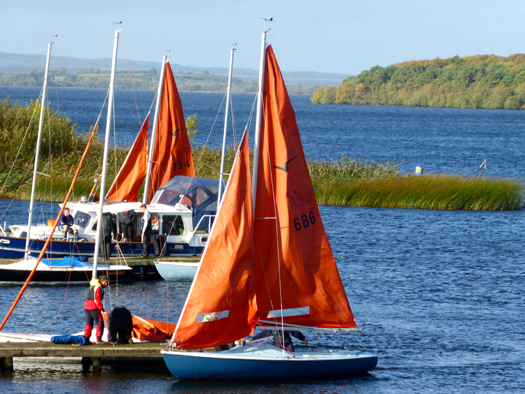
The Squibs might have been invented with Lough Derg YC's facilities in mind, as they are easy to berth on the outer harbour....Photo: W M Nixon
 ...yet even in an awkward breeze, they can head confidently for the narrow little East Dock.......Photo: W M Nixon
...yet even in an awkward breeze, they can head confidently for the narrow little East Dock.......Photo: W M Nixon
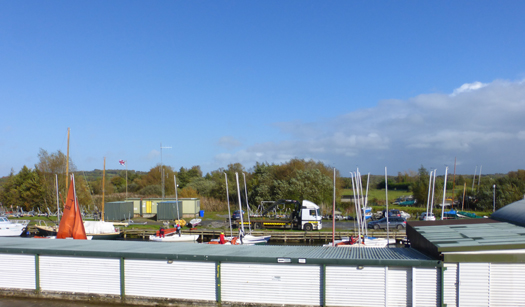
....and stay nicely under control while assessing the situation. This is Peter Kennedy's Whipper Snapper, which was top of the local boats at 11th overall in the Dromineer regatta. Photo: W M Nixon
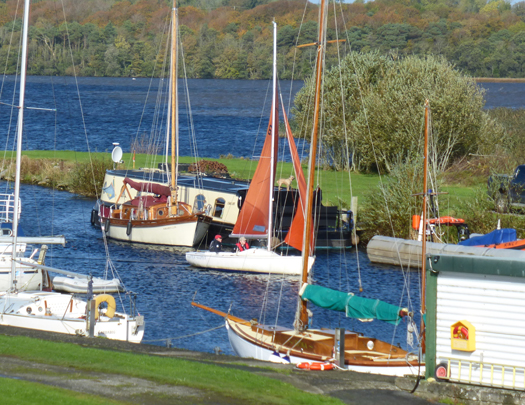
The Squib is so well mannered she'll wriggle up the most unlikely channel whatever the wind.........Photo: W M Nixon
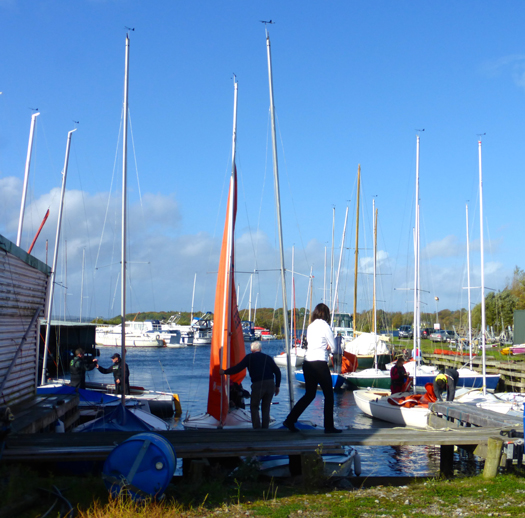
....and so Whipper Snapper reaches her berth right at the top of the dock with no bother at all. Photo: W M Nixon
As to the longterm health of the event, despite this year's problems for which we have to make some allowance for the extreme weather, there's no doubt everyone very much wants Dromineer to succeed as the venue for what has the potential to be a major and rather special keelboat regatta.
But as an outside observer who has been notably unsuccessful in running races himself, it seemed to me that when number start pushing towards the sixty mark and four classes are involved, then the visiting classes will have to expect to be bringing back-up support boats and some race officials with them. And that in turn will require a certain amount of diplomacy between the visitors and the established race administration at the hosting club. Yet that would be well worth the effort. For when the going was good at Dromineer, it was very good indeed.
LOUGH DERG YACHT CLUB KEELBOAT REGATTA 2014
International Dragon Class: 1st Phantom (Neil Hegarty, RStGYC) 3pts; 2nd Diva (Richard Goodbody, RIYC) 4pt; 3rd Jaguar (Martin Byrne, RStGYC) 7 pts; 4th Little Fella (Cameron Good, KYC) 9 pts; 5th Sir Ossis (Denis Bergin, RIYC) 13pts; 6th Cloud (Claire Hogan, RStGYC) 14pts. (15 raced).
National Squib Class: 1st Mucky Duck (James Matthews, KYC) 7pts; 2nd Quickstep (Gordon Paterson, RNIYC) 9pts; 3rd Inismara (Des Clayton, RNIYC) 15pts; 4th Fagan (Cian O'Regan, KYC) 15pts; 5th Femme Fatale (Vincent Delany, RStGYC) 15 pts; 6th Perfection (Jill Fleming, RStGYC) 17pts; 7th Pintail (Tonia McAllister, NYC) 37pts; 8th Sidewinder (Rupert Bowen, RStGYC) 40 pts (23 raced).

When the going gets too rough on Lough Derg, the prudent Dromineer mariner will seek a secure berth in the Whiskey Still to watch the rugby. Photo: W M Nixon
Defending Champion Wins Dragon Gold Cup in Medemblik
#dragon – Defending champion Markus Wieser has retained the Dragon Gold Cup. The professional sailor, competing for the United Arab Emirates, was in the lead of the 70th Dragon Gold Cup the whole week, but didn't get it all his own way. Lawrie Smith (GBR), Yevgen Braslativ (UAE) and Lars Haigh (DEN) were close at various points. Dutchman Pieter Heerema scored a second place overall after six races. First Corinthian was Poul Richard Hoj-Jensen who finished in sixth place overall. Ireland's Martin Byrne, Adam Winkelmann and Prof O'Connell, the only Irish boat competing were 44th in the 86-boat fleet.
The 70th Dragon Gold Cup in Medemblik, was sailed from 7 to 12 September. On the opening day on Sunday there was no race due to lack of wind and also on Tuesday. These races were resailed on Monday and Wednesday, therefore all six scheduled races eventually were sailed. The conditions were perfect, especially on the two last days. Moderate to strong wind, a light chop and plenty of Sun.
Final top five:
1. Markus Wieser, Pugachev Sergey, Leonchuk Georgii, UAE, 42
2. Pieter Heerema, Theis Palm, Claus Olesen, NED, 59
3. Braslavets Yevgen, Sidorov Igor, Timokhov Sergiy, UAE, 61
4. Lars Hendriksen, Frithjof Kleen, Pedro Andrade, DEN, 70
5. Anatoly Loginov, Vadim Statsenko, Alexander Shalagin, RUS, 74
More here
#dragonsailing – Lawrie Smith showed his mettle to take the 2014 Irish Dragon Nationals at Kinsale YC today writes Claire Bateman. Britian's Smith with crew Adam Bowers and Jack Wilson and sailing under the Burgee of the Glandore Harbour Yacht Club won today's two races to take the title on a day when the wind never went above 8 knots from the south east. It was a close run thing with two other boats on similar points and it went to a tie break to decide the winner. Neil Hegarty's Phantom with crew David and Peter Bowring from RStGYC were second and first Corinthian entrants. Martin Payne and crew Dominic and Olivia Bakker in Little Hooka from Salcombe Yacht Club were third overall.
Due to lack of wind no racing took place on Friday. An early start was made on Saturday in an attempt to get in three races but this was not to be and two races were sailed in a breeze of about six knots. A patient Race Committee waited about an hour after the second race to watch an approaching shower in the hope there would be some wind following but this did not happen and racing finished for the day. However that being said six of the seven races scheduled for the event were sailed.
Results HERE.
Lack of Wind Scrubs Dragon Racing off Kinsale
#dragon – The second day of the Irish Dragon nationals at Kinsale in County Cork has been scrubbed due to lack of wind. Racing is scheduled to start an hour earlier tomorrow at 11am.



























